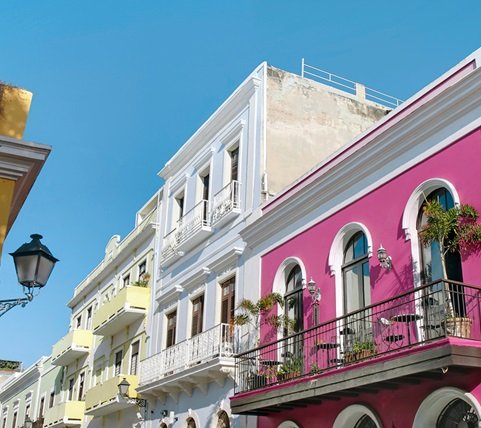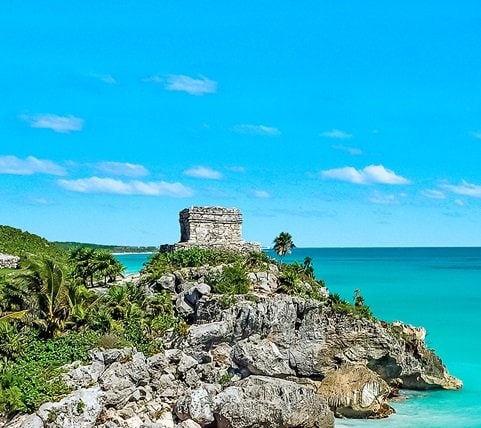
CARIBBEAN CRUISES

Islands, bays, and coral reefs. The Caribbean is a feeling that drags you with the seductive rhythm of tropical vibes. Imbibe in an ambiance where the clock seems to stop ticking! Is the time to indulge in that Caribbean cruise you've been longing for. Walk among long stretches of white sandy beaches, lie under the balmy shade of magnificent palm trees and dive into a turquoise sea full of coral reefs. Our Caribbean cruises offer the most extensive discovery of idyllic archipelagos.
Experience the essence of a Caribbean vacation come to life also on board your MSC cruise, as the rhythm of steel drums and reggae captivates your senses, enhancing your journey through the stunning Caribbean destinations. MSC Cruises even owns a private Caribbean Island! Ocean Cay MSC Marine Reserve, located in the stunning Western Bahamas. This tropical paradise was specially crafted to provide our guests with the most exclusive Caribbean dream!
Caribbean Islands
Have you ever wondered how many islands are in the Caribbean? More than 700! Don't know where to start? MSC Cruises' itineraries offer the best of what you could wish for your ultimate tropical escape! Choose from a wide range of routes crossing West and East Caribbean.Take in the Bahamas, the Dominican Republic or Cayman Islands (Grand Cayman). As well as Honduras, Jamaica, Puerto Rico and Mexico’s lesser-known island of Cozumel and historic Costa Maya. MSC Cruises' itineraries can also include the bright lights and big personality of tropical Miami, and Florida’s Space Coast (Port Canaveral).
Western Caribbean cruises itineraries
Start your Western Caribbean cruise from Miami or Port Canaveral. Get the best start to your Bahamas cruise with the exclusive atmosphere of Ocean Cay MSC Marine Reserve. While in Nassau, you can swim with dolphins in the Crystal-clear waters of Balmoral Island! For your Jamaica cruise, experience the thrilling cascades of Dunn’s River Falls from Ocho Rios. Swim in the waterfall plunge pools and enjoy nature’s ‘massage’ as the cascades pummel your shoulders.
Did you know the world’s second largest barrier reef are on the island of Roatan in Honduras? Roatan is one of the picture-perfect stops of MSC's Western Caribbean cruise and is well known among diving aficionados as it offers some of the best diving in the world! For your cruise to Mexico, soak up the ambiance of Costa Maya and discover the glorious and mystical Mayan culture. Join us on excursions to two different sets of Mayan ruins: Chacchoben and Kohunlich. If sea adventures are more your thing, sail to the Mexican island of Cozumel. With so many natural wonders and cultural experiences to enjoy, a Western Caribbean cruise promises an indelible journey.
Western Caribbean cruises itineraries

Eastern Caribbean cruises itineraries
Sail from Miami and Port Canaveral (Orlando) to islands whose names alone inspires an adventurous vibe. It could not be otherwise for an Eastern Caribbean cruise! Think Puerto Rico and you probably think Salsa - it’s the ‘sauce’ that makes parties happen! You’ll have authentic dance moves to last a lifetime. During your cruise to Puerto Rico, take an excursion in the capital, San Juan, and you’ll come home with more than memories! In the Dominican Republic, experience the flavors of Puerto Plata. With MSC Cruises excursions you can even visit a local cigar factory and a rum house. Looking to fulfill your dream of swimming with dolphins? Ocean World in Puerto Plata offers a unique tour that allows you to get up close with marine life!
Sail away to the rhythm of gentle waves in Guadalupe or Martinique. While with a Lesser Antilles cruise, explore St. Lucia, Barbados, or go even further south to Trinidad and Tobago. Nature and nightlife, thrilling adventures or awe-inspiring history, Eastern Caribbean needs to be experienced to be believed!
Eastern Caribbean cruises itineraries

Ocean Cay MSC Marine Reserve: your own private island
Discover our new and exclusive Bahamian destination: Ocean Cay MSC Marine Reserve. In Ocean Cay you disembark onto a beautiful private island, packed with watersports, beaches and attractions. Here you can connect with nature and feel the warmth of the Bahamian spirit!
On Ocean Cay you can enjoy a relaxing massage in a cabana and explore the area with dedicated excursions. As a nature-focused marine reserve, Ocean Cay demonstrates MSC Cruises long-standing love of the sea. Early birds will want to wake for a sunrise and mimosas cruise and watch dawn break over the Caribbean seas.
Connect with the waters and choose from an array of watersports: a WaveRunner tour, snorkeling or kayaking and much more. Take a look around the 360 virtual tour!
Ocean Cay MSC Marine Reserve: your own private island

BEST CARIBBEAN CRUISES
Discover the best itineraries onboard the newest ship MSC World AmericaCaribbean cruise deals
Choose the best Caribbean cruise deals in 2025 and 2026 and start planning your lifetime adventure. Relax on white sand beaches, snorkel in crystal-clear waters and enjoy the unique blend of cultures in the Caribbean with MSC's last minute Caribbean cruises. Explore stunning destinations such as Bahamas, Jamaica, Dominican Republic and beyond with the best Caribbean cruise deals.
a new world of cruising
Discover a world where elegant European design meets American comfort on board MSC World America, a new ship class to cruise the CaribbeanCaribbean ports
Caribbean islands are a melting pot of emotions following the seductive rhythm of tropical vibes. For your Caribbean cruise, MSC Cruises provides a broad selection of ports, including both embarkation points and ports of call. The main embarkation ports for your Western and Eastern Caribbean cruises are Miami and Port Canaveral (Orlando).Our carefully crafted itineraries range from 3 or 4-night Mini Caribbean cruises up to 7-, 11- or 18-night itineraries across West and East Caribbean. You can count on many ports of call for your tropical adventures. From Fort de France in Martinique and Kingstown in Saint Vincent, or Bahama's capital Nassau and Ocho Rios in Jamaica, just to name a few of the exciting port of calls on your Caribbean cruise.

Cruises from Miami
Miami is perfect for your shopping, with the Dolphin Mall being a top choice. Passionate about art? Then the Wynwood Art District is the perfect place for you, with its galleries, museums and its celebrated street art. Miami is the perfect start for your Caribbean cruise!

Cruises from Port Canaveral (Orlando)
Located just 45 miles east of Orlando, Port Canaveral is one of the departure ports for Caribbean cruises. Even before your Caribbean adventure begins, you can visit extraordinary sights. Port Canaveral is worldwide known for its Space Coast, that features the phenomenal Kennedy Space Center.
Learn about NASA's space vehicles and experience a space shuttle launch simulation with MSC Cruises' excursions. Or head to Cocoa Beach, the world's surfing capital and home to the massive Ron Jon Surf Shop. Be surprised before your adventure to the Eastern and Western Caribbean begins!
view all Caribbean & Southern Caribbean ports
- Basseterre, Saint Kitts and Nevis
- Belize City, Belize
- Bridgetown, Barbados
- Cartagena, Colombia
- Castries, Saint Lucia
- Charlotte Amalie (St Tomas), United States
- Colón, Republic of Panama
- Costa Maya, Mexico
- Cozumel, Mexico
- Freeport, Bahamas
- Galveston, United States
- Georgetown, Cayman Islands
- Isla de Roatan, Honduras
- Key West (Florida), United States
- Kingstown, Saint Vincent
- Miami, United States
- Nassau, Bahamas
- Ocean Cay MSC Marine Reserve, Bahamas
- Oranjestad, Aruba
- Orlando (Port Canaveral), United States
- Philipsburg, Saint Maarten
- Port of Spain, Trinidad and Tobago
- Progreso, Mexico
- Puerto Limon, Costa Rica
- Road Town (Tortola), British Virgin Islands
- Roseau, Dominica
- Royal Naval Dockyard, Bermuda
- Saint George, Grenada
- San Juan, Puerto Rico
- St Johns, Antigua and Barbuda
- Tampa, United States
- Willemstad, Curacao
















